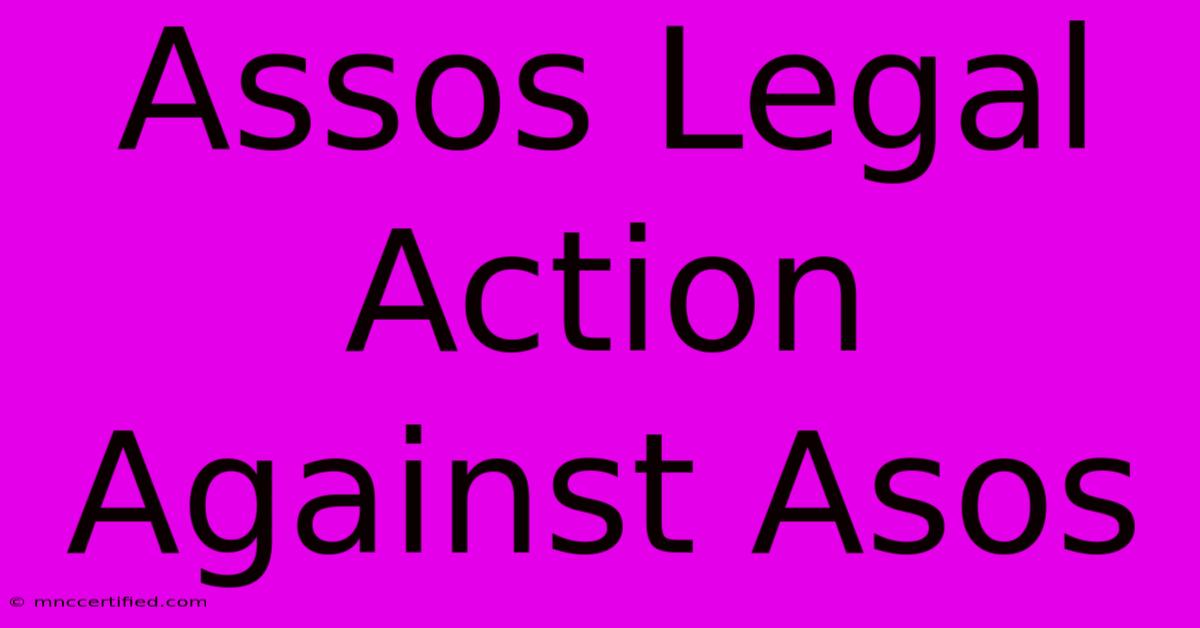Assos Legal Action Against Asos

Table of Contents
Assos Legal Action Against ASOS: A Deep Dive into the Trademark Dispute
The high-profile legal battle between Swiss cycling apparel giant Assos and online fashion retailer ASOS highlights the crucial importance of trademark protection and brand identity in the fiercely competitive global marketplace. This article delves into the specifics of the case, explores the legal arguments, and analyzes the broader implications for businesses striving to protect their intellectual property.
The Core of the Dispute: Trademark Infringement
The crux of the issue lies in the similarity of the names "Assos" and "ASOS." Assos, a renowned manufacturer of high-performance cycling apparel, argued that ASOS's use of its name constituted trademark infringement and caused consumer confusion. This confusion, Assos claimed, diluted their brand recognition and potentially misled customers into believing a connection existed between the two companies. The similarity in both the sound and visual appearance of the names formed the bedrock of Assos's legal claim.
Assos's Arguments: Protecting Brand Equity
Assos's legal action aimed to protect its substantial brand equity built over decades. Their argument centered on several key points:
- Established Reputation: Assos highlighted its long-standing reputation and significant market share within the cycling apparel industry. They presented evidence of substantial brand awareness and recognition amongst cycling enthusiasts worldwide.
- Consumer Confusion: They argued convincingly that the similarity in names was likely to cause confusion among consumers, particularly online, where brand differentiation can be challenging.
- Dilution of Brand Value: The potential for consumer confusion directly threatens the value of the Assos brand, leading to a dilution of its carefully cultivated image and market position.
ASOS's Defense and Counterarguments
While ASOS hasn't publicly detailed its full defense strategy, it’s likely they contested the claim of significant consumer confusion and argued that the differences between the two brands, particularly in terms of product lines and target markets, were substantial enough to prevent any material confusion. Their defense likely focused on:
- Distinct Target Markets: Arguably, ASOS caters to a broader fashion-conscious audience, while Assos focuses on a niche cycling market. This distinction could minimize the likelihood of direct consumer confusion.
- Brand Differentiation: ASOS might have emphasized its distinct brand identity and visual presentation, arguing that these factors clearly differentiate it from Assos.
The Outcome and Implications
The specific outcome of the legal proceedings between Assos and ASOS is crucial for understanding the application of trademark law in similar disputes. The case serves as a strong reminder to businesses of the importance of:
- Thorough Trademark Searches: Before launching a brand or product, conducting comprehensive trademark searches is paramount to avoid potential conflicts.
- Strong Brand Identity: Developing a unique and easily recognizable brand identity can significantly reduce the risk of confusion with other brands.
- Aggressively Protecting Intellectual Property: Companies must be prepared to actively protect their trademarks from infringement, regardless of the size or perceived strength of the infringing party.
This case highlights the complexities of trademark law and the significant challenges companies face in protecting their brand identity in an increasingly interconnected global market. The decision, whatever it may be, will set a precedent for future cases involving similar trademark disputes. The ongoing discussion surrounding the Assos vs. ASOS case continues to be a valuable learning opportunity for all businesses looking to safeguard their intellectual property rights. Staying informed about legal developments in this area is crucial for any company operating in a competitive market environment.

Thank you for visiting our website wich cover about Assos Legal Action Against Asos. We hope the information provided has been useful to you. Feel free to contact us if you have any questions or need further assistance. See you next time and dont miss to bookmark.
Featured Posts
-
John Lewis Christmas Ad Critiqued
Nov 15, 2024
-
Bond No 9 Lafayette Street Reviews
Nov 15, 2024
-
The Onions Infowars Purchase Jones Anger
Nov 15, 2024
-
713 401 9563 New Horizon Insurance
Nov 15, 2024
-
Disneys Double Standards Zegler Speaks
Nov 15, 2024